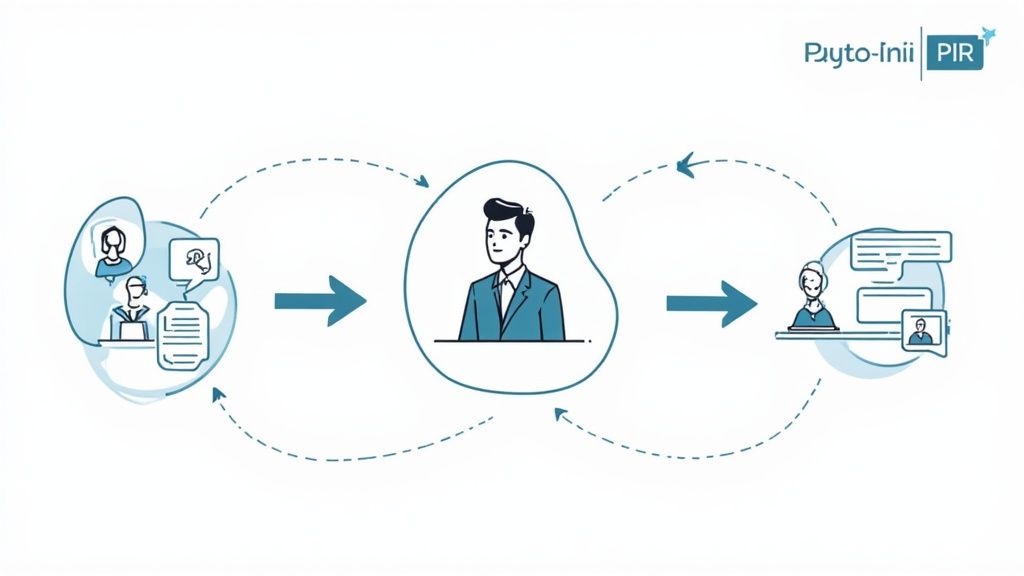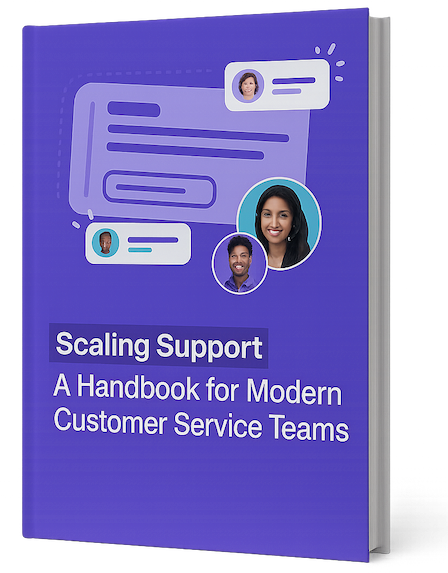Great customer service starts with putting customers at the center of everything you do. Rather than just reacting to problems as they arise, successful companies take a proactive approach – anticipating needs, building relationships, and focusing on the deeper “why” behind customer requests. This shift creates loyal customers who stick around for the long term.
Understanding the Modern Customer
Customers today interact with companies through many different channels – email, social media, phone calls, and live chat. When someone reaches out for help, they expect the support team to know their history and provide consistent service no matter how they get in touch. Breaking down communication barriers between departments is key. According to Salesforce, 73% of customers use multiple channels to contact businesses, making seamless service across all touchpoints essential.
Key Components of a Customer-First Approach
Creating truly customer-focused service requires several core elements:
- Proactive Engagement: Take the initiative to help customers before issues come up. Share useful resources, personalized recommendations, and important updates to show you care about their success.
- Personal Touch: Get to know your customers and make them feel valued. Use what you learn about them to anticipate needs and provide customized solutions – like their favorite coffee shop remembering their usual order.
- Empowered Teams: Give your support staff the tools, training and authority they need to solve problems effectively. When employees feel trusted to make decisions that benefit customers, better service naturally follows.
- Data-Driven Improvement: Track key metrics like Customer Satisfaction Score (CSAT) and Net Promoter Score (NPS) to measure how you’re doing. Look for patterns in the data to keep making service better. Research by Bain & Company shows that companies who monitor NPS tend to grow faster than competitors.
Implementing a Customer-First Strategy
Making customers your top priority requires commitment from everyone in the organization. Beyond just adding new technology, you need to build customer focus into your culture:
- Lead with Empathy: Train your team to truly understand customer perspectives and respond with genuine care.
- Use Smart Tools: Invest in systems that streamline communication, handle routine tasks, and provide customer insights. This frees up your team to focus on building relationships.
- Welcome Feedback: Actively ask customers what they think and use their input to keep improving. See feedback as a valuable opportunity to strengthen connections.
By following these principles, companies can move beyond basic problem-solving to create enthusiastic customer advocates. When you consistently put customers first, you build the foundation for lasting success through genuine relationships and word-of-mouth growth.
Mastering the Art of Personal Connection
Taking your customer-first strategy to the next level requires focusing on what truly connects with customers – genuine human relationships. Behind each support ticket and phone call is a real person with unique needs, concerns and emotions. When your team understands and responds to customers as individuals, you create the kind of memorable experiences that build lasting loyalty.
Why Personalization Matters
Making customers feel personally understood goes far beyond just using their name. It means showing that you truly get their specific situation and needs. Consider how you feel when interacting with an unhelpful automated system versus a friendly service person who remembers your preferences. Research by Epsilon shows that 80% of customers prefer doing business with companies offering personalized experiences. This makes personalization essential for any service-focused business.
Reading the Signals: Understanding Your Customer
Good personalization starts with excellent listening skills. Train your team to pick up on both what customers directly say and the underlying meaning – their tone, word choice, and non-verbal signals can tell you a lot. For example, if someone sounds frustrated, they likely need extra patience and reassurance. Looking at their past interactions and purchase history also helps you understand their needs better and even predict what they might need next.
Adapting Communication Styles for Maximum Impact
Just as you speak differently to a close friend versus a work colleague, your team should adjust their communication style for each customer. Some people want brief, direct responses while others prefer a warmer, more detailed approach. Give your team the freedom to match their tone and language to what works best for each person. This shows customers you respect their preferences and time.
Creating Memorable Service Moments
While solving problems efficiently matters, the best service creates positive memories that stick with customers long after. These don’t have to be big gestures – sometimes small acts of thoughtfulness make the biggest impact. Maybe it’s proactively sending a helpful resource or checking back after resolving an issue to ensure they’re happy. These extra touches show you truly care about the customer as a person, not just a transaction. When customers feel that genuine connection, they’re much more likely to become loyal advocates for your business.
Measuring What Truly Matters in Customer Service

At its core, customer service is about building real connections and crafting experiences that resonate with each customer. But without the right measurements in place, it’s difficult to tell if these efforts are actually making a difference. Much like a doctor runs specific tests to check a patient’s health, businesses need clear metrics to understand how well their customer service is performing.
Key Metrics for Measuring Service Success
To get a complete picture of customer service effectiveness, focus on these essential metrics:
- Customer Satisfaction Score (CSAT): This simple but powerful metric directly shows how happy customers are after specific interactions. Think of it like giving a thumbs up or down after getting help. CSAT helps identify which aspects of your service need work and which are hitting the mark.
- Net Promoter Score (NPS): NPS measures whether customers would recommend your business to others – a key sign of real loyalty. When customers become enthusiastic advocates, it often leads to organic growth through word-of-mouth. Studies show companies that track and improve NPS tend to see faster growth.
- First Response Time (FRT): Quick responses matter to customers. FRT tracks how fast your team first gets back to customer questions. Research shows most customers expect a response within 30 minutes, making this a critical metric for meeting basic service expectations.
- Resolution Time: While responding quickly is important, actually solving the issue is what counts. This metric measures how long it takes to fully resolve customer problems. Just as patients appreciate a doctor who can quickly diagnose and treat their condition, customers value support teams that can efficiently solve their issues.
Implementing Effective Measurement Systems
Having the right metrics is just the start. You also need a solid system to collect, analyze and act on the data:
- Integrate Measurement Tools: Use software that automatically tracks key metrics across all support channels for consistent data collection. For example, SupportMan helps teams monitor metrics in real-time as part of their normal workflow.
- Regular Review Schedule: Set up routine check-ins to analyze trends and spot areas needing improvement. For example, if satisfaction scores suddenly drop, it could signal an issue with a new feature or process that needs attention.
- Share Data with Teams: Make metrics visible to support staff and other departments so everyone understands their impact. Just as sports teams review game stats to improve strategy, sharing data helps teams optimize their performance.
- Take Action on Insights: Don’t just collect numbers – use them to drive improvements. When you spot issues, create specific plans to address them and track the results. For instance, if response times are lagging, you might adjust staffing or add automation tools.
By focusing on metrics that directly impact customer experience and building a culture of data-driven improvement, you create a continuous cycle of better service. This leads to more satisfied customers and stronger business results. The key is measuring what matters most and using those insights to keep getting better.
Creating Seamless Multi-Channel Experiences
Every customer interaction matters. From posting on social media to answering emails and taking phone calls, businesses must provide consistent, high-quality service across all channels. Research from Salesforce shows that 73% of customers expect this unified experience whenever they engage with a company. Meeting this expectation requires carefully coordinating service delivery across every touchpoint.
Why a Multi-Channel Approach Is Essential for Customer Service Best Practices
The modern customer journey rarely follows a straight line. A typical interaction might start with browsing your website, move to asking questions on social media, continue through email exchanges, and finally conclude with a phone purchase. Each of these touchpoints shapes how customers view your brand. When information gets stuck in departmental silos or channels don’t communicate well, it creates unnecessary friction. For example, a customer who explains an issue in chat shouldn’t have to repeat their entire story when following up by phone later. These disjointed experiences erode trust and make it harder to build lasting relationships.
Strategies for Successful Channel Integration
Creating a seamless experience requires aligning both your technology and your team approach. Here are key practices to implement:
- Centralized Customer Data: Set up a single system where support staff can access complete customer histories across all channels. Tools like SupportMan help by consolidating feedback from platforms like Intercom into Slack, giving everyone needed context.
- Proactive Communication: Stay ahead of customer needs by sharing updates across channels. When issues arise, update your FAQ, email affected customers, and post on social media to keep everyone informed before they need to ask for help.
- Consistent Brand Voice: Use the same friendly, professional tone whether responding on Twitter, Facebook, or email. This builds familiarity and trust through reliable, on-brand interactions.
- Empowered Support Teams: Give your representatives thorough training and integrated tools to handle inquiries from any channel effectively. This may mean cross-training on different platforms or providing unified software to manage all interactions.
Overcoming Common Multi-Channel Challenges
Building an effective multi-channel strategy comes with several common obstacles:
- Data Silos: When customer information gets trapped in separate systems, it fragments the customer view and makes personalized support harder to deliver.
- Inconsistent Service Levels: Different response times and service standards between channels can confuse and frustrate customers.
- Lack of Integration: When channels operate independently, customers waste time repeating information, leading to poor experiences.
The key to addressing these challenges is taking a strategic, customer-focused approach. Plan carefully, anticipate needs, and ensure quality remains consistent no matter how customers reach out. This moves support from reactive problem-solving to proactive relationship building across every channel.
Leveraging Technology Without Losing Humanity

Smart use of technology is essential for modern customer service, but it shouldn’t come at the expense of genuine human connection. The key is finding the sweet spot between automation and personal interaction that creates exceptional experiences. This means carefully choosing and implementing tools that make your team more effective while preserving authentic customer relationships.
The Power of AI: Enhancing, Not Replacing, Human Interaction
AI tools can significantly improve customer service operations when used thoughtfully. For example, chatbots handle routine questions, freeing up agents to focus on complex issues that need a human touch. AI can also analyze customer data to give agents valuable insights for anticipating needs rather than just reacting to problems. The goal is to use AI to support and strengthen human connections, not replace them entirely. This balanced approach allows your team to be proactive problem-solvers while maintaining genuine empathy in customer interactions.
Choosing the Right Tools for Your Team
Selecting new technology requires careful consideration of both your team’s requirements and your customers’ needs. Take SupportMan for instance – it combines customer feedback directly with Slack, letting teams discuss ratings and metrics in real-time. This improves communication and helps build a culture focused on constant improvement. For other companies, investing in a comprehensive CRM might work better by centralizing customer data across channels. The focus should be on picking tools that make your team’s workflow smoother and enable more personalized service.
Training AI Systems Effectively: The Key to Seamless Service
The effectiveness of AI tools depends entirely on their training data. To ensure your AI provides accurate and helpful responses, it needs thorough training using diverse information that represents your full customer base. This isn’t a one-time thing – continuous updates and refinements are crucial. If a chatbot regularly misunderstands customer questions, it quickly damages trust. Regular monitoring and improvement of AI systems is essential for using technology effectively in customer service.
Maintaining the Human Touch in a Digital World
Despite increasing automation, human connection remains vital in customer service. People seek genuine empathy and understanding, particularly during complex or emotionally charged situations. While AI handles routine tasks well, human agents excel at nuanced conversations and relationship building. That’s why investing in training programs focused on empathy, listening skills, and clear communication is more important than ever. The most effective customer service combines efficient technology with genuine human warmth and understanding. It’s like a carefully choreographed performance – technology provides structure and support, while human empathy leads the way. This balanced approach creates lasting customer loyalty and truly outstanding service experiences.
Building and Empowering High-Performance Teams

Great customer service doesn’t happen by chance – it requires building strong, capable teams who work together seamlessly. Much like any high-performing group, service teams need careful selection, ongoing development, and the right environment to succeed. Let’s explore how to build teams that consistently deliver excellent customer experiences.
Hiring the Right People: The Foundation of Great Service
Finding the right people is critical when building a customer service team. While you can teach technical skills, qualities like empathy and genuine care for others are innate. During interviews, focus on evaluating communication abilities and emotional intelligence rather than just reviewing resumes. For instance, present real customer scenarios and watch how candidates respond – do they listen carefully and work to understand the root cause? These behavioral indicators reveal whether someone has the core traits needed for customer service success.
Training for Success: Equipping Your Team with the Right Tools
Even naturally empathetic people need proper training to excel in customer service. This means going beyond basic product knowledge to develop crucial skills like effective communication, conflict resolution, and tool proficiency. Your training should cover how to adapt communication styles across different channels and customer situations. When teams get comprehensive training, they gain confidence and deliver more consistent, high-quality service.
Fostering a Culture of Empowerment: Building Team Potential
Teams perform best when they feel trusted and supported. This requires creating clear guidelines while giving agents room to make decisions and solve problems independently. Tools like SupportMan help by connecting customer feedback directly to Slack, enabling teams to learn from each experience and continuously improve. When agents see how their work impacts customer satisfaction, they take more ownership and drive better results. Open communication and psychological safety also help teams naturally develop and share best practices.
Motivation and Recognition: Celebrating Success and Driving Growth
Like any team, customer service professionals thrive on recognition of their achievements. Take time to highlight both individual and group successes, whether it’s sharing a particularly positive customer interaction in team meetings or creating formal reward programs. This positive reinforcement builds team spirit and motivates everyone to maintain high standards, creating better experiences for both employees and customers.
Building successful customer service teams comes down to finding empathetic people, training them well, empowering them to succeed, and fostering a positive environment. When these elements come together, teams become a true competitive advantage – driving loyalty, referrals, and business growth.
Ready to help your customer service team reach their full potential? Start your free trial of SupportMan today and see how real-time feedback and seamless communication can transform your team. https://supportman.io


